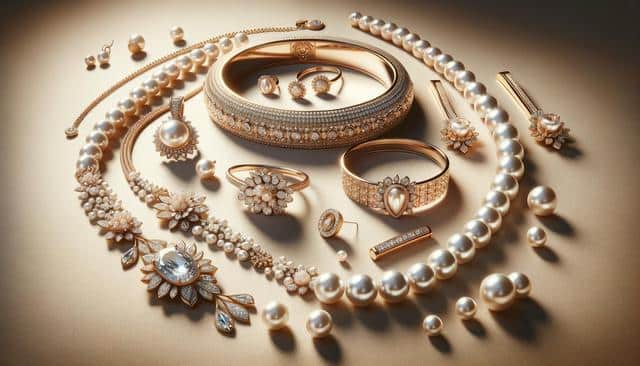
Timeless Appeal: Exploring the World of Jewelry
The Historical Significance of Jewelry
Jewelry has been woven into human history for thousands of years, offering insight into traditions, beliefs, and societal structures across time. From ancient Egyptian amulets to Roman rings and Renaissance brooches, each era brought with it a unique design language and purpose. In many cultures, jewelry served not only as adornment but also as a status symbol and spiritual talisman. For example, in ancient India, gold jewelry was believed to bring prosperity and protection, while in China, jade pieces symbolized purity and moral integrity.
Materials used in historical jewelry were often chosen for their symbolic meanings. Precious stones like rubies, emeralds, and sapphires were favored for their vibrant colors and perceived powers. Metals such as gold and silver were associated with wealth and divine favor. Additionally, many early civilizations used jewelry in ceremonial practices, making it an integral part of both public and private life.
Key historical uses of jewelry include:
- Religious and spiritual ceremonies
- Royal regalia and authority symbols
- Dowries and bridal adornments
- Commemorative gifts and heirlooms
Understanding these roots allows us to appreciate not just the aesthetic beauty of jewelry, but also its role in human storytelling and legacy.
Materials and Craftsmanship
Jewelry creation involves a wide range of materials and techniques, each contributing to the final piece’s uniqueness and value. Traditional materials include gold, silver, and platinum for the base, while diamonds, pearls, and colored gemstones add visual interest and luxury. In recent years, alternative materials such as titanium, recycled metals, and synthetic stones have gained popularity among eco-conscious consumers.
Craftsmanship plays a crucial role in the final product. Skilled artisans use methods such as hand-tooling, stone setting, and enameling to achieve intricate designs. Techniques like filigree, engraving, and casting are passed down through generations, blending heritage with innovation. Modern technology, including 3D printing and computer-aided design (CAD), has also expanded what is possible in jewelry design, allowing for more precision and customization.
Key elements that define high-quality craftsmanship include:
- Attention to detail and symmetry
- Secure stone settings
- Polished finishes and smooth edges
- Durability of design and structure
Whether handcrafted or produced using advanced tools, the craftsmanship behind each piece significantly influences its aesthetic and emotional value.
Jewelry as a Form of Self-Expression
Beyond its historical and material significance, jewelry serves as a personal statement. Individuals choose pieces that reflect their identity, style, and values. For some, minimalist designs represent elegance and simplicity, while others prefer bold, vibrant pieces that command attention. Cultural and familial influences also play a role, with traditional motifs often passed down through generations.
Jewelry can also mark life’s milestones—engagement rings, graduation pendants, and anniversary bracelets all carry deep emotional weight. Personalized pieces, such as engraved lockets or birthstone rings, make meaningful gifts that celebrate relationships and achievements.
Common reasons people wear jewelry include:
- Commemorating a special occasion
- Expressing cultural heritage
- Enhancing personal style
- Symbolizing emotional connections
In this way, jewelry becomes more than decoration—it becomes a wearable narrative that evolves alongside the wearer’s life story.
Trends in Contemporary Jewelry
The world of jewelry is continuously evolving, influenced by fashion trends, technological advancements, and shifting consumer values. Currently, there is a growing interest in sustainable and ethically sourced pieces. Consumers are asking more questions about where their jewelry comes from and how it is made, leading to greater transparency in the supply chain.
Minimalist designs, stackable rings, and layered necklaces are popular among those who prefer versatility and subtle elegance. On the other hand, statement pieces with bold colors and unconventional shapes are gaining traction among fashion-forward individuals looking to make a visual impact. Vintage and antique jewelry has also seen a resurgence, valued for its craftsmanship and historical charm.
Emerging trends include:
- Use of lab-grown diamonds and gemstones
- Customization and personalization options
- Mixed-metal combinations
- Gender-neutral designs
These trends reflect a broader shift in how people view jewelry—not just as a luxury, but as an extension of their identity, values, and lifestyle.
Caring for Your Jewelry Collection
Proper care and maintenance are essential to preserving the beauty and longevity of your jewelry. Different materials require different approaches. For instance, pearls should be kept away from chemicals and stored flat to avoid scratches, while silver items benefit from regular polishing to prevent tarnish.
Regular cleaning, safe storage, and periodic inspections help ensure that your pieces remain in excellent condition over time. It’s also advisable to have valuable or sentimental items professionally cleaned and checked for loose settings or wear. Additionally, storing jewelry in a cool, dry place—preferably in a lined box or pouch—can prevent damage caused by humidity and contact with other items.
Tips for maintaining your jewelry:
- Remove jewelry before swimming, exercising, or using household cleaners
- Store items separately to prevent scratching
- Use a soft cloth to gently clean pieces after wearing
- Schedule regular maintenance with a trusted jeweler
With proper care, your jewelry can remain a cherished part of your collection and potentially become heirlooms that are passed on for generations.
Conclusion: Embracing the Beauty and Meaning of Jewelry
Jewelry holds a multifaceted place in our lives—serving as adornment, expression, and connection to history and culture. Whether you’re drawn to its artistic design, material value, or sentimental meaning, jewelry offers a unique way to celebrate individuality and mark life’s special moments. As trends evolve and consumer awareness grows, the appeal of well-crafted, ethically made pieces continues to rise. By investing time in understanding and caring for your jewelry, you ensure that each piece remains a lasting symbol of your personal journey.


